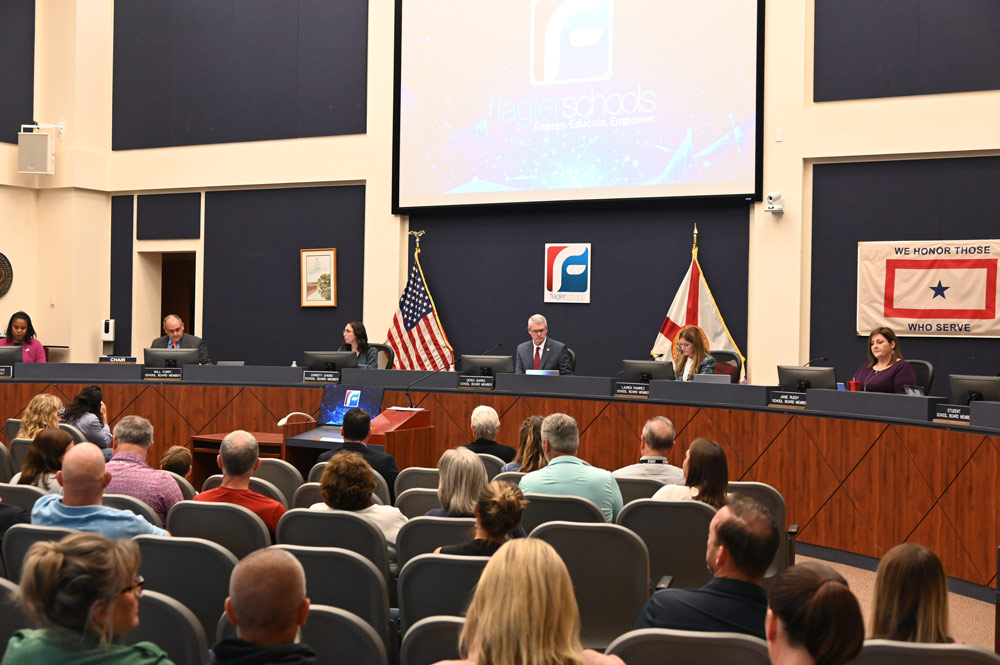
If Flagler County School Board members aren’t panicking over next year’s budget, they’re either putting on a good act or not fully grasping the breadth of the rapidly changing financial landscape and disappearing dollars that district staff outlined for them at a meeting Tuesday.
Large parts of the budget are cloaked in smoke and mirrors–not because district staff is playing with the numbers, but because the federal and state governments are requiring the district to bank on dollars it will never see, or dollars that may never materialize, even though the dollars have to be included in the budget.
More than $17 million, or 10 percent of the $163 million general fund budget, appears as a line item in that budget. But the district will never see a dime of it. The state is awarding those tax dollars to families to subsidize private and parochial education at public expense under the guise of “choice,” while requiring districts to include the allocation in their budgets.
The $17 million figure represents more of a siphoning of dollars the district should have had than an allocation, reducing its actual general fund budget to $146 million. The $17 million accounts for all Flagler County students receiving state “vouchers” to attend private schools or subsidies for home-schooling. That includes private-school students who may never have enrolled in public schools. But it now includes an increasing number of students who are de-enrolling from public school to go to private school.
This year’s sum going to vouchers in Flagler schools’ budget is 67 percent higher than last year ($10.2 million).
The district is expecting a net loss of several hundred students when school resumes next month, and with it a loss of state dollars.
“In preparing for the 25-26 fiscal year budget, we knew things were going to be tight based on our FTE forecast that had us projected going down 140 students on top of what we did lose in 24-25,” Patti Wormeck, who heads the district’s finance department, said.
The fewer the number of students, the fewer teachers and other staffing positions the district can pay for. For now, the district is accounting for lost position not by firing employees but by letting attrition do the work. “The schools worked very hard with district staff to make sure that that did happen, so we feel pretty good about those numbers,” Wormeck said.
The losses may yet be steeper. “While we do have registrations for new students, we typically lose a few 100 kids the first 10 days of school for those who do not show up,” she said. That’s because the district goes on the previous year’s enrollment, as long as parents haven’t unenrolled their child.
In anticipation for the losses, all departments reduced budgets by up to 4 percent “to ensure the budget impact is felt districtwide,” Wormeck said.
The district has cut back on professional development, which means less training for existing staff. The focus right now is preservation of staff, Superintendent LaShakia Moore said.
Then there’s the federal smoke and mirrors.
In March the president, who a majority of the school board supports unquestioningly (and one of whom the president nominated to serve in his administration), signed an executive order abolishing the federal Department of Education and its workforce of 4,100. Half that workforce has already been dismissed. Though the federal government funds only about 10 percent of local schools’ budgets, the money pays for services for the most vulnerable students, such as Title I, which helps students from low-income families, and subsidies for school breakfast and lunch programs. The Flagler County school district received $21.2 million in federal dollars last year. It is expecting to receive $17.8 million this year. But some of that money is on hold, creating uncertainty locally.
“Currently we are experiencing a withholding period on Title II, Title III and Title IV,” Tammy Yorke, coordinator of federal programs at Flagler schools, said.
Title II funding supports staff professional development. Title III funds English education for migrants. Title IV funds social and emotional learning, STEAM education (Science, Technology, Engineering, Arts, and Mathematics), safety and other initiatives.
Together, the four funds add up to $800,000 for Flagler schools. The state is allowing the district to use unspent funds from last year to fund those programs this year. But that’s just a temporary fix, and it’s only $250,000.
“So we’ll be looking at what staffing might be in place that we need to maintain salaries for, or what critical resources to support students in the schools would be purchased out of those grants, and those would be our top priorities,” Yorke said. Meanwhile, the district is hoping additional federal funds are released. “So it’s going to be kind of a juggling we’re hopeful, and we’re waiting.”
“We don’t want to negatively impact our staff at this point,” Moore told the School Board. “If the dollars are not released, and if we are not given a different direction about our ability to cover some of those items in general, then we will have to come before you and address what we will do with our staffing, how this impacts our staffing.”
Moore said there’s no clear legal direction from the state on whether the district can use general fund dollars to cover federal programs once those programs run out of federal dollars. “What we do know, though, is that the general fund cannot absorb all of what is done in federal dollars,” Moore said. “That’s not just a Flagler thing. That is across the state. We cannot absorb all of those positions into the general fund.”
The superintendent said she was hoping that the funds will be released soon. There was no discussion about next year, by which time the federal Education Department may be non-existent.
Beyond the financial hit, Yorke said the loss of the programs would have severe consequences for students. “Those opportunities for our students are invaluable,” Yorke said. “The things they get to experience and the opportunities that they have really lend themselves well to really growing academics over the summer and getting kids engaged in excitement about learning. And so those are the things that we would really be saddened if we couldn’t continue to support. So we’re always looking at how we can enhance and go above and beyond. And that would be one of the major issues that we would have, is a lot of those, you know, really above and beyond and innovative things that we do would be lost with the loss of these dollars.”
“You’re absolutely right with the above and beyond portions. I think that’s what makes us stand out in a lot of different ways, for sure,” Bard member Derek Barrs–the Trump appointee–said.
Barrs inexplicably went on to almost shift the blame on the district: “That’s the risk that we all take when we take grand dollars. We know that when we get them,” he said, though those dollars’ availability or purpose or value to students, as Yorke had just described, have not been in question for decades. “So they’re great, but they can change, and your whole budgetary process can be thrown upside down with it. So I think that’s the understanding of the communication piece that I know that we have to communicate with staff, and I know that you’ll be doing that. But that’s the risk that we take of taking any kind of grants.”
“I think the difference here is that these are long-standing supplemental grants. The term grant is almost a misnomer,” Board member Janie Ruddy said. Moore more accurately referred to the money as an entitlement. Ruddy described the direct impacts of federal dollars she saw in action when she was a teacher, as when a student of hers was able to learn English thanks to Title III.
“Those are the real stories that are happening,” Ruddy continued, “and it would be a disgrace to, let’s say, just have that child sit in the corner saying, well, good luck, I guess, what are we going to do here? And so those are the real stories, the real impact, which I think I’m nervous of having a negative influence on the progress we’ve made here.”
The president’s administration has placed about a dozen districts in Florida under review as it studies how those districts are spending federal dollars. Flagler County is not among those 12.










